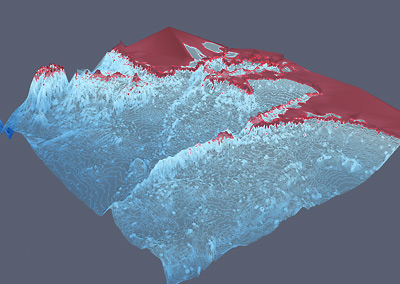Scientific Visualization
The complexity of systems (complex geometries, dynamic evolution, multi- physics systems) often makes one or more views of the whole or the details indispensable. Today advanced 2D and 3D visualization has therefore become a primary tool in numerous scientific fields.

With the evolution of simulation codes, measurement instruments, scientific visualization and the analysis of scientific data in general, we have seen the emergence of new technical challenges in the last few years, requiring a review of all the tools and approaches that have been available until now:
– Volume of data: With the generalization of 3D models, the number of database tools has exploded. Non-structured meshes of several hundred million elements are possible today. Because of their impact on memory size, local processing with dedicated workstations has become impossible and imposes heavy processing loads on remote computers. Only the final result, in the form of images or 3D scenes, is then transferred to the client machine.
The need for efficient processing of large dataset has led to the development of highly parallel processing engines like Cassandra-PCS, based on validated open-source technologies like Java, VTK, X3D, ProActive and MPI.
– Complexity of data and processing: Numerical models are becoming more and more fine-grained, measuring instruments higher and higher performing, the data created richer and richer and, in the case of numerical data, close to reality itself. Processing therefore requires new tool, beyond the simple cutting plane, allowing the extraction of pertinent information (noise reduction, exploration of phase spaces, iso-contours...)
The most complex analysis work leads to combine numerous filters in the form of a processing pipeline that must be adaptable, configurable and extensible. New tools like Cassandra meet these challenges.
– nterdisciplinary teamwork: The scientific process itself has evolved. Research is conducted more and more by teams, sometimes in different locations and very often in interdisciplinary fields. So communication, collaboration and exchange of information has become the critical challenge. For practical purposes, this has led to develop new platform solutions of collaborative work for scientific visualization in the case of R & D projects like SCOS and Collaviz, supported by the French National Agency of Research (ANR).




 French
French English
English